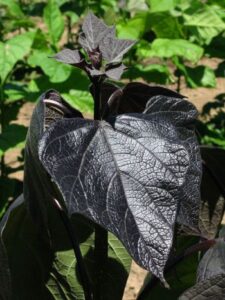With the hotter days of the year upon us, consider adding a flowering shade tree to your landscape. The following unique trees will add beauty and fragrance to your garden, and provide the cooling effects that only a tree can provide.
Japanese Tree Lilac – “Ivory Silk”
Syringa reticulata ‘Ivory Silk”
Height: 20’ | Spread: 15’
Shape: Upright, rounded
Zone: 4
Leaf color: Dark green
Flowers: White clusters, fragrant
Fall color: Yellow’
Growth: Moderately Fast
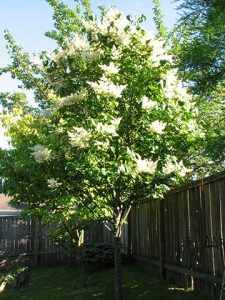 If you’re looking to maximize your Lilac bloom season into the Summer, look no further than a Japanese Tree Lilac. These upright trees feature large clusters of fragrant white blossoms that bloom in late Spring. The lilac-scented fragrance of the flowers will waft all around your yard for weeks.
If you’re looking to maximize your Lilac bloom season into the Summer, look no further than a Japanese Tree Lilac. These upright trees feature large clusters of fragrant white blossoms that bloom in late Spring. The lilac-scented fragrance of the flowers will waft all around your yard for weeks.
Japanese tree lilacs are part of the wider Lilac family and are related to the familiar European and Korean lilacs that are landscape staples in northern Utah. However, unlike their cousins, these lilacs grow into a tree, either groomed into a single trunk or manicured as a multiple trunk specimen. Another unique feature is their tendency to have speckled, exfoliating bark.
The Ivory Silk Tree Lilac is a small, upright-growing tree with clusters of fragrant, lilac-scented creamy-white blossoms in mid-June. This tree can be grown in a single trunk form or as a multi-stem tree.
Care: Tree Lilacs tolerate a range of soils, drought and tough, urban conditions. Typically maxing out near 20’ tall, they are an excellent choice for a low-maintenance park-strip tree.
Purple-Leaf Catalpa
Catalpa x erubescens ‘Purpurea’
Height: 50’ | Spread: 40’
Shape: Tall, rounded
Zone: 5
Leaf: Emerges purple then fades to green
Flowers: White, tubular
Fall color: Yellow
Growth: Fast
The Purple Catalpa is a hybrid selection of the more commonly planted green Catalpa tree seen throughout many established neighborhoods. Growing just as tall and stately, the Purple-leaf Catalpa will become a large shade tree with huge, elephant-ear shaped leaves that emerge purple and fade to bronze-green. Clusters of tubular, orchid-like white flowers flecked with yellow and purple bloom in late Spring and into Summer, covering the tree’s canopy.
This purple-leaf variety is a hybrid of the North American native Catalpa bignonioides and the Chinese Catalpa ovata. It received the Royal Horticultural Society’s Award of Garden Merit in 1993.
Care: What makes Catalpa trees even more attractive is their tolerance to a wide range of soil conditions, including high pH, clay and compacted urban soil, as well as secondary water. They are also tolerant of heat and periodic drought.
Chitalpa – “Strawberry Moon”
Chitalpa tashkentensis ‘Strawberry Moon’
Height: 20’-40’ | Spread: 20’-35’
Shape: Rounded, open
Zone: 6
Leaf: Green
Flowers: White, tubular in clusters
Fall color: Yellow
Growth: Fast
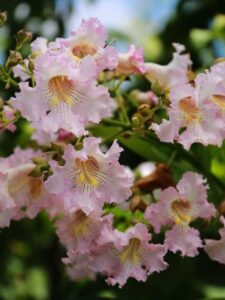 People looking for drought-tolerant flowering trees have been very excited about the idea of Chitalpas – a cross of full size Catalpas (Catalpa speciosa) and the more shrubby, Southwestern-US native Desert Willow (Chilopsis linearis). This intergeneric hybrid was first created in Uzbekistan, then the Soviet Union, in the 1960s, resulting in a bigger tree than a Desert Willow with exceptional drought-tolerance.
People looking for drought-tolerant flowering trees have been very excited about the idea of Chitalpas – a cross of full size Catalpas (Catalpa speciosa) and the more shrubby, Southwestern-US native Desert Willow (Chilopsis linearis). This intergeneric hybrid was first created in Uzbekistan, then the Soviet Union, in the 1960s, resulting in a bigger tree than a Desert Willow with exceptional drought-tolerance.
As interest increases in Desert Willows and Chitalpas, more and more cultivars are becoming commercially available. One such variety is Strawberry Moon, which produces fewer seeds than other Chitalpas. The tree forms a handsome, upright, open-branched crown covered in dark green leaves that cast cool shade. Pink, orchid-like blooms are produced heavily in early summer with sporadic rebloom through the season. Fall foliage is a bright yellow.
Care: Chitalpas are tolerant of drought, so provided it’s properly established, it’s great for a xeric landscape design. Some winter dieback may happen in colder winters. A sunny, western exposure would be an ideal placement.
As with many tree varieties, growth rates here in Utah will vary compared to other parts of the country where trees tend to get bigger. For Strawberry Moon, expect a reliable 25′ tall and a 20′ spread, possibly larger with time.
Goldenrain Tree
Koelreuteria paniculata
Height: 30’ | Spread: 30’
Shape: Rounded
Zone: 5
Leaf: Dark green
Flowers: Yellow clusters, fragrant
Fall color: Amber orange
Growth: Fast
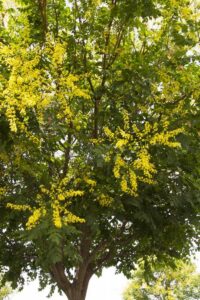 If you’re already counting down the days until next season’s Forsythia bloom, the bright yellow flowers of the Goldenrain Tree will certainly tide you over until then. These trees have been cultivated in China and East Asia for centuries and are prized for their beautiful flowers that cover the tree in early Summer.
If you’re already counting down the days until next season’s Forsythia bloom, the bright yellow flowers of the Goldenrain Tree will certainly tide you over until then. These trees have been cultivated in China and East Asia for centuries and are prized for their beautiful flowers that cover the tree in early Summer.
The Goldenrain Tree is a small-to-medium sized flowering shade tree with a dense, rounded crown and pinnately compound, lobed leaves. Starting in mid-to-late June, sprays of fragrant yellow flowers emerge all over the tree, attracting bees and butterflies in droves. Following its flowers are papery red seedpods that resemble lanterns, which persist through Winter. The seedpods and leaves turn to a pale amber in Fall providing intense autumn color.
Care: Goldenrain Trees are a preferred choice for a beautiful tree in tough sites with harsh exposures. They are tolerant of drought, heat, alkaline soils and poor, compacted, salt-ridden urban environments.
Mimosa / Silk Tree
Albizia julibrissin
Cultivars: ‘E.H. Wilson’, ‘Ombrella’, ‘Tropical Dream’
Height: 20’-30’ | Spread: 20’-30’
Shape: Upright, spreading
Zone: 6
Leaf: Pinnately compound, Green
Flowers: Pink
Fall color: Yellow
Growth: Fast
 If a tropical vibe is more your style, try planting a Mimosa tree. Hardy to Zone 6 and perfectly happy in hot climates, the Mimosa, or Silk Tree, quickly grows a large vase-shaped, flat topped canopy of shade. Its leaves are small and bipinnately compound, giving the tree a graceful fern-like appearance and dappled shade for those relaxing underneath it.
If a tropical vibe is more your style, try planting a Mimosa tree. Hardy to Zone 6 and perfectly happy in hot climates, the Mimosa, or Silk Tree, quickly grows a large vase-shaped, flat topped canopy of shade. Its leaves are small and bipinnately compound, giving the tree a graceful fern-like appearance and dappled shade for those relaxing underneath it.
Adding to the already exotic appeal of its fine-textured foliage are the tree’s stunning flowers: masses of bright pink, filamentous blooms that cover the tree starting in late Spring and extending for several weeks into early Summer. These silky flowers look like fluffy pom-poms and give off a moderate sweet fragrance. The flowers attract bees, butterflies and hummingbirds, making the Mimosa a great addition to a pollinator-friendly garden.
Care: Mimosas prefer full sun, but may need a more protected planting location that isn’t out in the open. They can handle periodic drought, but perform best with regular, deep watering. Though Mimosas readily self-sow and are considered invasive in warmer climates, young seedlings rarely survive cold winters.
Southern Magnolia
Magnolia grandiflora
Cultivars: ‘Bracken’s Brown Beauty’, ‘D.D. Blanchard’, ‘Edith Bogue’
Height: 20’-30’ | Spread: 15’-20’
Shape: Upright, pyramidal
Zone: 6
Leaf: Dark green, brown undersides
Flowers: White
Growth: Moderate
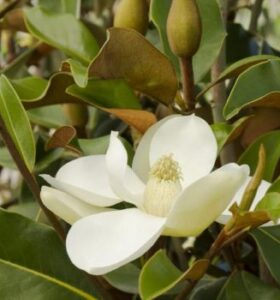 Gardeners accustomed to Utah’s dry climate may be surprised to find specimens of Magnolia grandiflora, a broadleaf evergreen tree native to the hot and humid Southeast, growing along the Wasatch Front. Evergreen even in cold winters (hardy to Zone 6), come summer, these unique trees produce large white flowers with an intensely sweet scent.
Gardeners accustomed to Utah’s dry climate may be surprised to find specimens of Magnolia grandiflora, a broadleaf evergreen tree native to the hot and humid Southeast, growing along the Wasatch Front. Evergreen even in cold winters (hardy to Zone 6), come summer, these unique trees produce large white flowers with an intensely sweet scent.
Southern Magnolias grow in an upright, pyramidal habit with a straight trunk and dense branching. Its leaves are large, leathery, dark-green ovals with rusty-brown undersides and remain on the tree through winter. Large, fragrant, creamy-white flowers emerge in June, providing a stunning display throughout the Summer.
In their native range, these Magnolias can grow to massive sizes, up to 80’ at full maturity. In Utah’s drier conditions with often harsh, cold winters, expect a much slower growth rate and smaller stature – 30’ is more reasonable.
Care: In the right protected locations, these magnificent trees can do well and provide gorgeous blooms through the Summer. Plant in a full to partial sun location protected from desiccating winter winds. Exposure to snow fall is fine, and you may want to water periodically through the winter to help keep the tree well hydrated.
Though these trees hold their leaves through the winter, they do drop leaves periodically throughout the growing season. Cleaning up large, thick leaves and flower petals is considered a nuisance by some.
